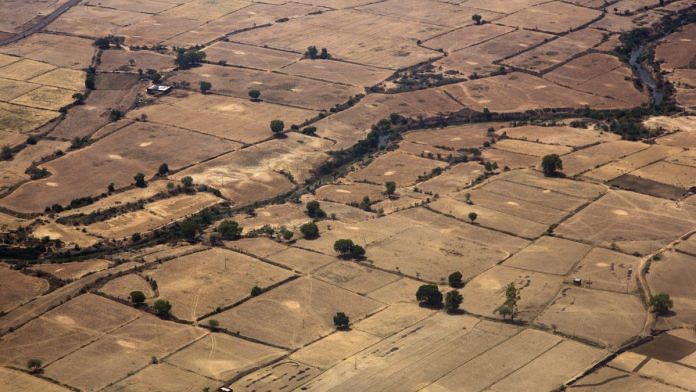New Delhi: The Narendra Modi government is planning to ‘converge’ various land and water schemes to reclaim degraded land and prevent further loss of arable pastures. Officials from the Ministry of Environment, Forest and Climate Change (MoEF&CC) said the government aims to set a voluntary target for land degradation neutrality.
India will host the 14th session of the Conference of Parties (COP-14) to the United Nations Convention to Combat Desertification (UNCCD) from 2-13 September, 2019. Issues such as desertification, land degradation and drought will be discussed in the meet. COP-14 is being led by the MoEF&CC.
An analysis of remotely sensed data by ISRO in 2016 had revealed that 96.40 million hectares or 29.32 per cent of the Total Geographic Area (TGA) of India faces the threat of degradation.
Land degradation is essentially any undesirable change to a piece of land.
“Much of it is in the states of Rajasthan, Jharkhand and Gujarat. The situation is not very good,” said Anuradha Singh, Director, Desertification Cell, MoEF&CC.
She also said the economic costs of land degradation in India constitutes about 2.5 per cent of its GDP. Economical costs are associated with lost crop production, lesser availability of grasslands and degradation of forests, among others.
Pia Sethi, senior fellow at the forestry and biodiversity division of The Energy and Resources Institute (TERI), emphasised that it will cost India far less to reclaim land than the costs it is bearing due to degradation.
India has a number of state schemes and initiatives that look at various aspects contributing to land degradation — water management and aforestation for example.
Land degradation and food security
Singh also said the government has documented some efficient practices to reclaim land at the grassroots level.
“Budget available for all land and water related schemes in Centre and the states is enough to solve the problem of degradation. But we need to converge these schemes in order to utilise our resources effectively,” she added.
She also said the process of voluntary target setting for land degradation neutrality, under the UNCCD, is under way and should conclude over the next few months.
Land degradation is closely linked to a number of socio-economic issues. With climate change already affecting crop produce and populations increasing at an alarming pace, degraded land poses a further threat to food security in the future.
As more and more land becomes unfit for use, populations are likely to migrate in search for greener pastures which might further lead to conflict situations.
Ashok Kumar Jain, adviser at Niti Aayog, pointed out: “Various measures have been taken to tackle land degradation and water use efficiently in agriculture under the Accelerated Irrigation Benefit Programme (AIBP), Integrated Watershed Management Programme (IWMP), More Crop per Drop, and Har Khet ko Pani schemes.”
“The most effective principle of rainfed and degraded area development is conservation and efficient use of natural resources,” said Umakant, Joint Secretary, Department of Land Resources, Ministry of Rural Development.
“We have treated and brought about 20.45 million hectares of area under the category of protective variation. We are planning to treat another 62-63 million hectares of land,” he added.
Also read: Geo-tagging – one of the secrets behind the success of Modi govt’s welfare schemes
Watersheds, rainwater harvesting pits to combat drought
A Ravindra, director of WASSAN (Watershed Support Service and Activities Network), believes more investment is needed to encourage rainwater harvesting since 61 per cent of India’s farmers relay on rainfed agriculture. WASSAN works with communities to adopt watershed management practices.
A watershed is an area of land that feeds all the water running under it and draining it off into a body of water.
Highlighting positive initiatives at the state level, Manas Satpathy, executive director of NGO PRADAN (Professional Assistance for Development Action), said, “The state governments of West Bengal and Chhattisgarh have initiated large-scale programmes, involving rural women’s institutions and civil society organisations (CSOs) to develop land and water resources, as well as to rejuvenate rivers under MGNREGA”.
He highlighted one such initiative in which paddy farmers were encouraged to dedicate 2 per cent of their land to water harvesting pits that stored rainwater. This helped farmers during drought and when hit by lesser than average rainfall.
By 2030, it is estimated, 40.7 per cent of the world’s population will be living in water-stressed regions. Out of 328 million hectares of land in India, nearly 147 million hectares is undergoing some form of degradation.
COP-14 will see participation from over 196 countries, science and research communities, the private sector, international and non-governmental organisations.
The parties to the convention will agree on the actions each will take over the next two years and beyond to transition towards a sustainable development path. As of now, 122 countries in the world have committed to setting land degradation neutrality goals. While two-thirds of them have already announced theirs, others are in the process of doing so.
Also read: India’s woeful land records will have trouble identifying farmers eligible for Rs 500/month



